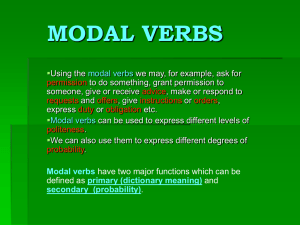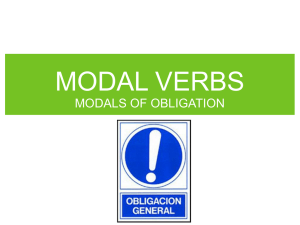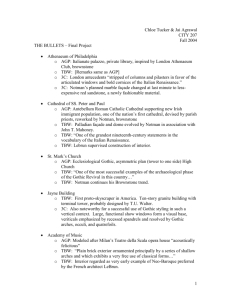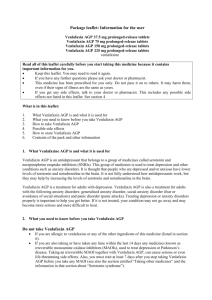Where Voice meets Modality
advertisement
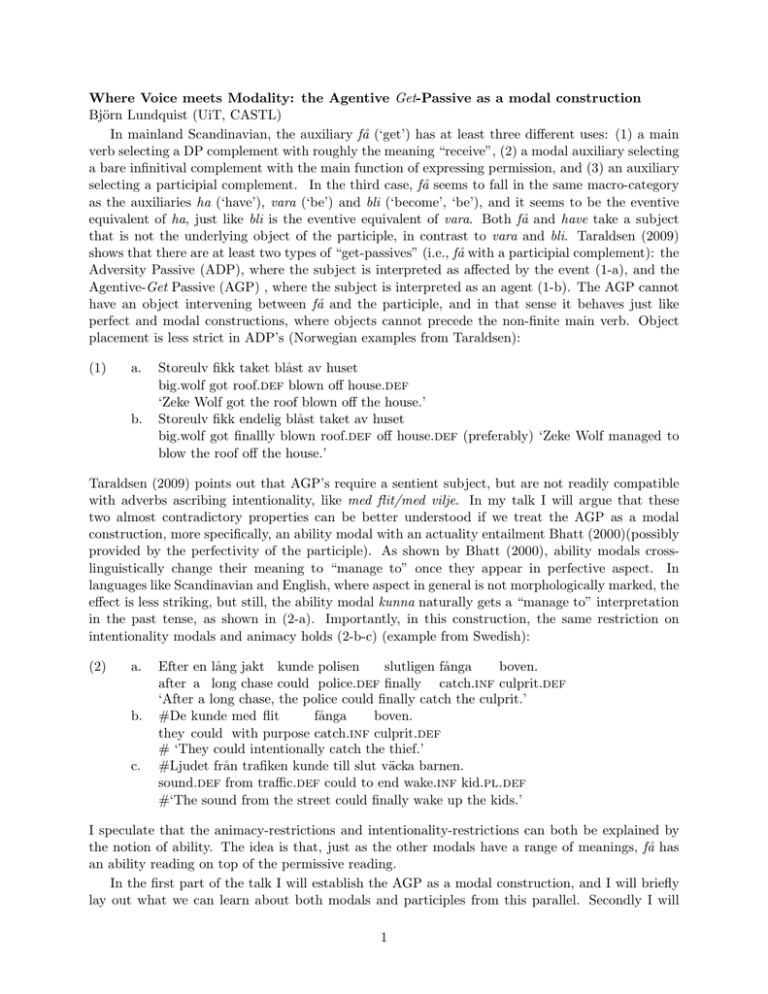
Where Voice meets Modality: the Agentive Get-Passive as a modal construction Bj¨orn Lundquist (UiT, CASTL) In mainland Scandinavian, the auxiliary f˚ a (‘get’) has at least three different uses: (1) a main verb selecting a DP complement with roughly the meaning “receive”, (2) a modal auxiliary selecting a bare infinitival complement with the main function of expressing permission, and (3) an auxiliary selecting a participial complement. In the third case, f˚ a seems to fall in the same macro-category as the auxiliaries ha (‘have’), vara (‘be’) and bli (‘become’, ‘be’), and it seems to be the eventive equivalent of ha, just like bli is the eventive equivalent of vara. Both f˚ a and have take a subject that is not the underlying object of the participle, in contrast to vara and bli. Taraldsen (2009) shows that there are at least two types of “get-passives” (i.e., f˚ a with a participial complement): the Adversity Passive (ADP), where the subject is interpreted as affected by the event (1-a), and the Agentive-Get Passive (AGP) , where the subject is interpreted as an agent (1-b). The AGP cannot have an object intervening between f˚ a and the participle, and in that sense it behaves just like perfect and modal constructions, where objects cannot precede the non-finite main verb. Object placement is less strict in ADP’s (Norwegian examples from Taraldsen): (1) a. b. Storeulv fikk taket bl˚ ast av huset big.wolf got roof.def blown off house.def ‘Zeke Wolf got the roof blown off the house.’ Storeulv fikk endelig bl˚ ast taket av huset big.wolf got finallly blown roof.def off house.def (preferably) ‘Zeke Wolf managed to blow the roof off the house.’ Taraldsen (2009) points out that AGP’s require a sentient subject, but are not readily compatible with adverbs ascribing intentionality, like med flit/med vilje. In my talk I will argue that these two almost contradictory properties can be better understood if we treat the AGP as a modal construction, more specifically, an ability modal with an actuality entailment Bhatt (2000)(possibly provided by the perfectivity of the participle). As shown by Bhatt (2000), ability modals crosslinguistically change their meaning to “manage to” once they appear in perfective aspect. In languages like Scandinavian and English, where aspect in general is not morphologically marked, the effect is less striking, but still, the ability modal kunna naturally gets a “manage to” interpretation in the past tense, as shown in (2-a). Importantly, in this construction, the same restriction on intentionality modals and animacy holds (2-b-c) (example from Swedish): (2) a. b. c. Efter en l˚ ang jakt kunde polisen slutligen f˚ anga boven. after a long chase could police.def finally catch.inf culprit.def ‘After a long chase, the police could finally catch the culprit.’ #De kunde med flit f˚ anga boven. they could with purpose catch.inf culprit.def # ‘They could intentionally catch the thief.’ #Ljudet fr˚ an trafiken kunde till slut v¨acka barnen. sound.def from traffic.def could to end wake.inf kid.pl.def #‘The sound from the street could finally wake up the kids.’ I speculate that the animacy-restrictions and intentionality-restrictions can both be explained by the notion of ability. The idea is that, just as the other modals have a range of meanings, f˚ a has an ability reading on top of the permissive reading. In the first part of the talk I will establish the AGP as a modal construction, and I will briefly lay out what we can learn about both modals and participles from this parallel. Secondly I will 1 look at the differences within Mainland Scandinavian with respect to AGP’s. AGP’s exist in all Mainland Scandinavian varieties, but they are much less frequent in Swedish than Norwegian (and Danish, as far as I am aware)(see Larsson 2009 for discussion of get-passives in Swedish). As far as I am aware, no one has ever pointed out differences in semantic restrictions within the MLS varieties. However, looking at AGP’s as modal constructions, one cross-linguistic difference becomes apparent: in cases where no actuality entailments hold (in e.g. generic contexts), the AGP is still available in Norwegian (3-a), but not in Swedish, where kunna + infinitive has to be used instead: (3) a. b. NO: Man f˚ ar kjøpt øl under middagen (i.e., it is possible to buy beer during the dinner) You/one get(s) bought beer during the dinner SW: *Man f˚ ar k¨opt ¨ol under middagen (only: Man kan k¨opa ¨ol under middagen) You/one get(s) bought beer during the dinner (only: You/one can buy beer during the dinner) References Bhatt, Rajesh. 2000. Covert Modality in Non-finite Contexts. Ph.D. thesis, University of Pennsylvania. Larsson, Ida. 2009. Participles in Time. Ph.D. thesis, G¨oteborgs Universitet, G¨oteborg. Taraldsen, Tarald. 2009. Unintentionally out of control. In Argument Structure and Syntactic Relations: A cross-linguistic perspective, edited by Maia Duguine, Susana Huidobro, and Nerea Madariaga, pp. 283–302. John Benjamins, Amsterdam. 2





